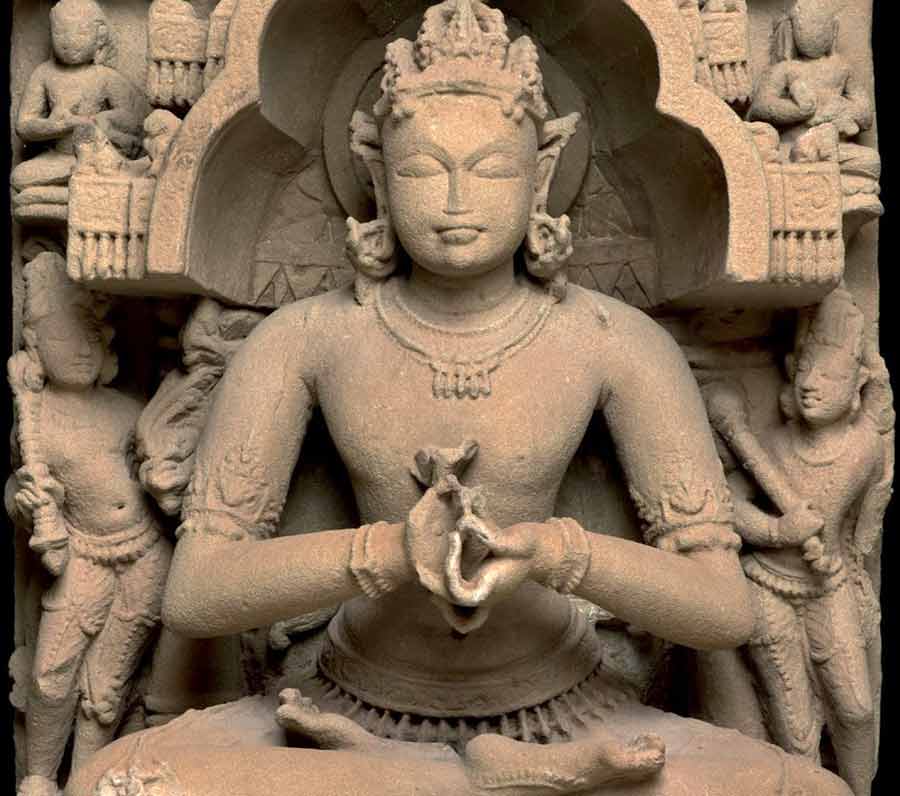
Detail of Temple Sculpture Representing Enshrined Bodhisatva
Manjushri Seated on a Lotus, Uttar Pradesh, 11th century. Cat. 165.
Editor’s Note:
‘Puja and Piety: Hindu, Jain, and Buddhist Art from the Indian Subcontinent’ is a major new exhibition at the Santa Barbara Museum of Art which opened
April 16th, 2016.
The exhibition celebrates the complexity of South Asian representation and iconography by examining the relationship between aesthetic expression and the
devotional practice, or puja, in the three native religions of the Indian subcontinent. Drawn from SBMA’s collection and augmented by loans, the exhibition
presents some 160 objects of diverse medium created over the past two millennia for temples, home worship, festivals, and roadside shrines. From monumental
painted temple hangings to meditation diagrams and portable pictures for pilgrims, from stone sculptures to processional bronzes and wooden chariots, from
ancient terracottas to various devotional objects for domestic shrines, this exhibition aims to examine and provide contextualized insights for both
classical and popular works of art.
This article is the first in a 4 part series featuring the catalogue introduction by Dr Pratapaditya Pal.
- See more at: https://www.sbma.net/exhibitions/puja#sthash.7CTbGZbd.dpuf
Use a picture. It’s worth a thousand words.
—Arthur Brisbane
Prologue
The visual images assembled in this exhibition originated 0n the Indian subcontinent comprising three sovereign states today: India, Pakistan, and
Bangladesh. Spanning a period of over two millennia, they were created by unknown artists and craftsmen in diverse materials as expressions of religious
piety. Most of the images were objects of veneration, whether at religious sites or in household shrines, and even the exceptions such as paintings on
paper of the last couple of centuries have religious content in the forms of myths, no matter what their function. Broadly, the objects served three
religions known today as Hinduism, Buddhism, and Jainism, belief systems that are all indigenous to India. The primacy of images (murti, pratima) among today’s Hindu worshippers has been affectingly discussed by Stephen Huyler in his essay in this catalogue with examples from the
past as well as the present. A few more words about the distant past, however, will not be redundant in this introduction. It is fashionable among
anthropologists to refer to examples of art as representative of “material culture,” but rather than serving material function, they were created primarily
for people’s spiritual needs. Art historians regard them as expressions of human aesthetic impulse, while the historians of religion generally ignore them
in their discourses, concentrating mostly on words or texts. But the fact remains that the objects in this exhibition, despite their present status in
museums and private collections as works of “art,” were expressions of piety and meant for use in puja, the Sanskrit word for veneration or
worship.
Indeed, the word puja is now part of the English lexicon and is included in most dictionaries. It has a more nuanced meaning than simple
veneration or worship with offering, and implies honoring and paying homage to superiors as well as the adoration of the Gods with unflinching devotion.
The first literary occurrence of the word is in the Hindu epic Mahabharata and the Grihyasutra (an aphoristic text for domestic rites and
rituals), which were both no earlier than the 5th century bce. Thus, the word does not appear in earlier Vedic texts where religious practice revolved
around sacrificial ritual, and “puja” (a word whose origin is uncertain) may well have been adopted from non-Vedic religious practices involving natural as
well as man-made objects symbolizing supernatural powers.
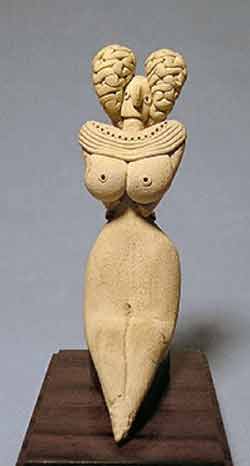
Fig. 1 Clay statue of a Goddess, Pakistan,
Mehrgarh, 3500–3000 bce, 7.5 cm.
Photograph courtesy Taiyo Ltd., Tokyo.
Archaeological evidence indicates that the feminine principle played a major role in this prehistoric and primitive mode of puja, which ultimately during
the historic period became assimilated with elements of Vedic religious praxis such as homage to the Fire God (homa) and other rites, and produced
the grand synthesis that is today’s elaborate Hindu worship. The process of assimilation was already achieved by the time of Mahavira and the Buddha in the
5th century bce, both of whom were against the sacrificial system. The synthesis is enunciated unambiguously in the Bhagavadgita, embedded in the Mahabharata, where the devotional mode of puja is highly recommended.
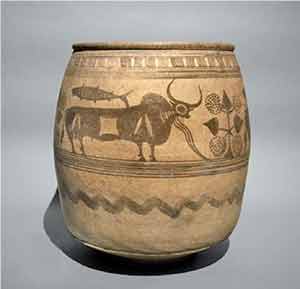
Fig. 2
Clay jar with painted sacred bull, fish, and pipal tree,
Pakistan, Mehrgarh, 3500–3000 bce, 43 x 37 cm.
Photograph courtesy Taiyo Ltd., Tokyo.
Some of the images in the exhibition received worship directly from the devotee or through the medium of a priest or monk, while others were created for
shrines or temples, both private and public, to serve didactic purposes as embodiments of spiritual or mythic ideals. No matter whether the representation
is of an imaginary deity or of a deified mortal (as is the case with the historical figures who founded Jainism and Buddhism), in religious praxis, the darshan (mutual eye-contact) with the image is of greater importance for most devotees than either hearing or reading the scriptures.
Early Forms and Motifs
The primary evidence of worship on the subcontinent is provided by archaeology rather than literature. While the earliest texts known as the Vedas are
generally regarded as having been composed around 1500 bce, the archaeological evidence is much older, going back at least another two millennia.[1] From the Neolithic site of Mehrgarh in the northwest of Pakistan have emerged both terracotta figures and painted pottery that were certainly
used in religious ritual. A typical specimen of a clay statue clearly served some kind of votive function and likely represented a Goddess, perhaps for
domestic worship because of its diminutive size (fig. 1).
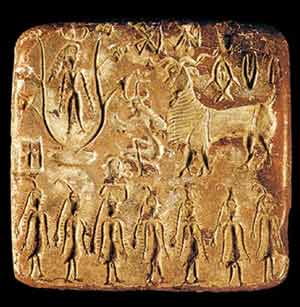
Fig. 3 Deity enclosed by leafy branches of pipal tree
forming an aureole, with diverse devotees, Pakistan,
Mohenjodaro, 2500–1500 bce, steatite. Islamabad
Museum, NMP, 50.295. Photograph: J. Kenoyer.
Reproduced with permission from Vajracharya 2013.
Apart from abstract geometric forms with unknown symbolic meaning, one predominant motif on the vessels from Mehrgarh is the pipal tree (fig. 2). This
particular tree (Ficus religiosa) and its leaf have remained an important feature of the art of the subcontinent, as is well known. Depictions of
this plant appear prominently in the archaeological remains of the Indus civilization, occurring frequently on seals and tablets in a context that clearly
indicates its sacerdotal character. To cite one example, leafy branches enclose an image of a deity like an aureole, approached by worshippers both human
and animal (fig. 3). Subsequently, the tree becomes an important symbol of wisdom beneath which the historical Buddha was enlightened; it is revered by the
Jains for being associated with one of their Jinas; and it is associated with the Hindu God Shiva as the archetypal divine teacher in his form known as
Dakshinamurti—shown seated under another ficus tree, the banyan (cat. 70).
The mango is another plant regarded as auspicious: its leaves are necessary in Hindu ritual worship, and it is associated with the Buddha as well. In
Jainism, it appears in most representations of the Goddess Ambika, forming a canopy above her head as she holds a bunch of its fruits as one of her
attributes (fig. 4).[2] Obviously functioning as a symbol of fertility, the religious significance of this delicious native fruit of the
subcontinent is clear from the evidence throughout the history of Indian art and more compelling for its easy recognition even by the illiterate, besides
its frequent use as a metaphor for spring, love, and auspiciousness in literature.
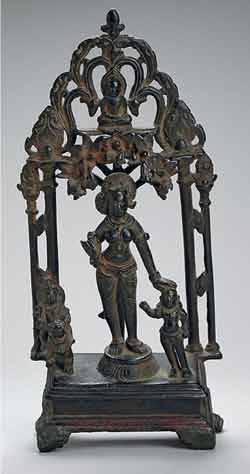
Fig. 4
The Goddess Ambika, Karnataka,
10th century, copper alloy,24.8 cm.
From the Nasli and Alice
Heeramaneck Collection,
Museum
Association Purchase,
LACMA M72.1,12. Courtesy LA County
Museum of Art. www.lacma.org
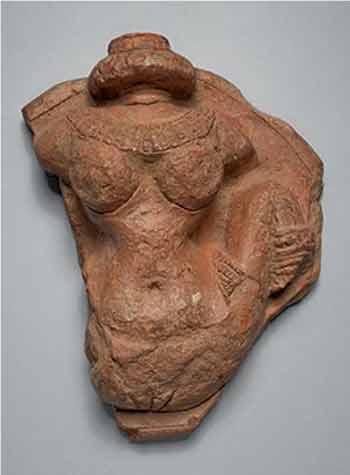
Fig. 5 Fertility Goddess with lotus flower head,
Uttar Pradesh, 1st–2nd century. Cat. 6.
Of all the plants, the lotus flower is the most ubiquitous motif in the arts of the three religions. As far as the archaeological evidence goes, its
occurrence is not common in the prehistoric period, but by the 2nd century bce it is included abundantly as an ornament and a popular symbolic motif. In a terracotta relief (fig. 5, cat. 6), it is encountered as the head of the Goddess seated in the birthing posture, while in a fragmentary
but earlier stone relief a stem of the flower is grasped in each hand by the Goddess Lakshmi (see cat. 22). By the Kushan period (2nd–3rd centuries ce), it
begins to appear as the seat of the Buddha as well as the halo, and by the Gupta period (4th–6th centuries) as the seat of both Gods and deified teachers.
The Jains, too, adopted the motif for the seats and halos of their Jinas, though later. In the beginning, the flower was regarded as a symbol of beauty,
purity, and auspiciousness, but later, especially in tantric and yogic meditational evocations, it became a symbol of the devotee’s heart.
Animal Symbolism
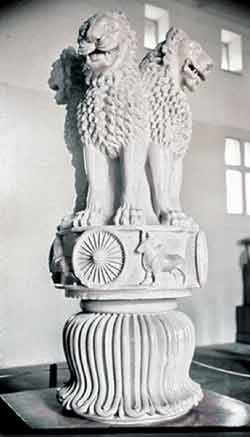
Fig. 6
Ashokan lion capital, Uttar Pradesh,
Sarnath, 3rd century bce, sandstone.
Sarnath Museum. Photograph courtesy P. Pal
The material remains of the Indus civilization offer other aspects of devotional worship that continue to survive in all three religions. The bull and the
elephant are two of the most familiar animals on the Indus seals. The bull (Vrisha) is a favorite motif in early terracotta art and coins, first as the
theriomorphic symbol of Shiva and then as his mount or vehicle (see cats. 63–65). Vrishabha- (or Rishabha-) natha, the very name of the first Jina, means
“the lord of the bull,” and the animal is one of his cognizants. In the case of the Buddha, metaphorically he is characterized as a bull among men, and the
Maurya emperor Ashoka (r. 265–238 bce) used the animal as the crowning element of his freestanding pillars, now displayed in the presidential palace in New
Delhi. The bull, elephant, lion, and horse serve as capitals on other cosmic pillars in stone that Ashoka raised across the subcontinent. The one at
Rummindei (Lumbini, Nepal) originally had a horse capital, while the elephant is found at Sankissa in Uttar Pradesh. The lion is frequently represented on
Ashokan capitals, most famously the one at Sarnath, site of the Buddha Shakyamuni’s first sermon (fig. 6). This capital, now missing the wheel atop, is the
emblem of today’s Indian nation. Along with the bull, the elephant and lion are ubiquitous sacred symbols with the Jains as well (see cats. 136, 140, 141,
143).
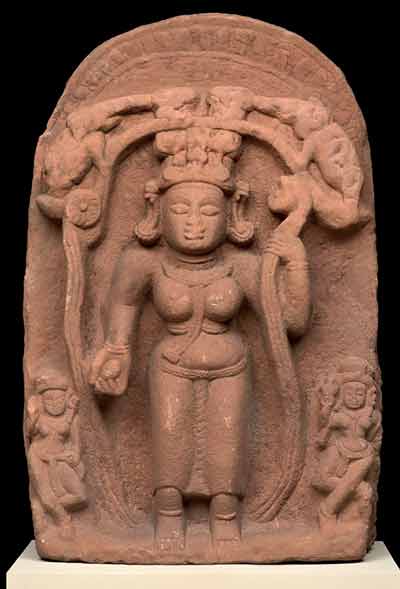
Fig. 7 The Goddess Lakshmi lustrated by elephants,
Madhya Pradesh, 8th–9th century. Cat. 23.
A white elephant is the mount of the Vedic deity Indra, who continued to play an important role in the mythologies of the Buddhists and Jains. Indeed, in
the stereotypical nativity story of the Jina or Tirthankara, Indra was responsible for transferring the embryo so that the Jina would be born to a woman of
the right varna, or class, while in the Buddha’s birth narrative his mother, Queen Maya, dreamed of a white elephant that entered her womb. In a
central Indian sandstone relief (fig. 7, cat. 23), we encounter two elephants pouring water on the head of a divine female who holds a lotus. Here the
pachyderm ( gaja) is a metaphor for the rain-bearing clouds without which the earth would remain infertile.[3] The figure is identified
as Gajalakshmi, Lakshmi being the Goddess of plenitude and fecundity. The festival of light (Diwali) in autumn is dedicated to her and observed by Hindus,
Buddhists, and Jains (see cat. 118) with equal zeal.
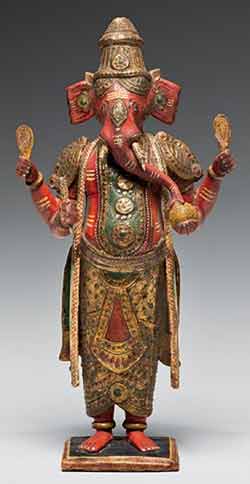
Fig. 8 Wooden image of Ganesha,
Karnataka, 19th century. Cat. 104.
The most enduring instance of the pachyderm’s popularity is the Hindu God Ganesha with an elephant’s head (fig. 8, cat. 104). The son of Shiva and Parvati,
Ganesha is the God of auspicious beginnings and remover of obstacles. Jains venerate him as well, while the Buddhists have a more ambivalent attitude.[4] He is invoked at the start of worship of every other Hindu deity, and all temples contain a subsidiary shrine with his image. His celebration
in August/September is the most important public religious festival in the state of Maharashtra, where he has become— along with the 17th-century Maratha
leader, Shivaji, who challenged Mughal hegemony—a symbol of Maratha subnationalism. Indeed, along with yoga, Ganesha may be the most familiar feature of
Hinduism globally. Although there are several myths explaining his animal head, he is clearly another survival of the therianthropic concept of divinity
seen also in some of the avatars of Vishnu (discussed below) and other animal- headed deities in both Buddhism and Jainism.
Popular Expressions of Piety
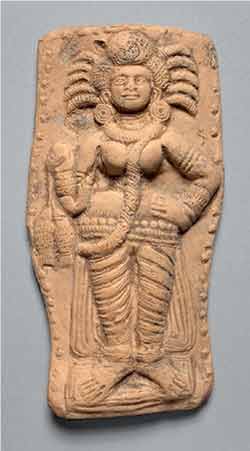
Fig. 9 Terracotta plaque showing a Goddess
of prosperity holding a pair of fish,
West Bengal, ca. 100 bce. Cat. 2
The small terracotta objects in the exhibition from various north Indian sites, depicting both male and female figures, constitute important evidence of
not only the quotidian concerns of the common people but also their piety in the two centuries around the beginning of the Common Era. Take, for example,
the molded plaque of a female holding a pair of fish in her right hand (fig. 9, cat. 2). On one level she can be identified as a fisherwoman, on the other
she is clearly a Goddess of good fortune and abundance, as a pair of fish has remained an important symbol of plenitude, especially—but not only—for those
making a living from fishing (see cat. 136 for a pair of fish on a Jain manuscript cover). Her claim to be considered a Goddess can also be determined by
her hieratic frontal posture, the mat below her feet, and the corncobs projecting from her head. This and other plaques (such as cat. 5, where clearly we
see the Goddess’s right hand displaying the gesture of varada, or charity, and receiving an offering in a bowl from a devotee) are more telling
images of popular piety than can be gleaned from any contemporary literature. It seems clear that all these unnamed figures made of clay are progenitors of
various Hindu, Jain, or Buddhist deities under different guises and names. The importance of the Goddess or the Feminine Principle in Indian religious
praxis not only is evident from the earliest archaeological remains but still continues across the subcontinent in national festivals such as Dussera or
Durga Puja and Diwali in autumn. She is the personification of Shakti or Energy among the Hindus, and Prajna or Vidya (Wisdom, Knowledge) among the
Buddhists and the Jains. She appears in countless forms in towns and villages, as is clear from even the limited selection here, in both benevolent and
awesome forms, as mother and spouse, as the scourge of the wicked, and as the savior of the devout. Indeed, the followers of the great Mother (as Shakti)
are known as Shakta among Hindus, just as those who believe in the supremacy of Vishnu/Krishna are known as Vaishnava, and of Shiva as Shaiva. At the same
time, all Gods are considered to be inert Purusha (Male) without their Prakriti (Nature, Female) the active agency. This idea came to flower in the final
phase of the development of religion on the subcontinent characterized by the rubric Tantra, which permeated all three religions after the Gupta period.
The Gods and Goddesses of all three belief systems generally mimic human emotions and activities, as is exemplified in the terracotta panel showing the
Goddess in the birthing posture (see fig. 5) and a Kushan-period fragment depicting a child playing between the feet of the Buddhist tutelary Goddess
Hariti, while an infant, as if newly born, is supported by her left arm (cat. 158). In a variation on the theme, Hariti is portrayed without children but
with a cornucopia in her hand, regally seated beside her consort Panchika, in a small schist relief from Gandhara (cat. 157). Here Panchika holds the
spear, thereby making him a guardian/protector figure, while in another small relief from the same region (cat. 156), he is still a weapon-bearing figure
but additionally holds a sack of money in his right hand and rests his feet on a pile of coins or gems. Thus, in addition to his protective role, he is a
deity (indicated by the halo) of wealth.
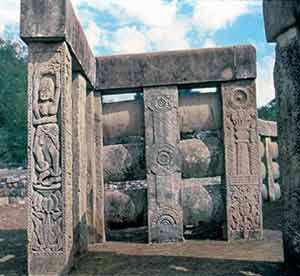
Fig. 10
Section of railing at Sanchi Stupa, 1st century bce,
showing a yakshi in the front column and a replica
of the Ashokan lion capital on the column behind (right),
with the surmounting Wheel of Law that is now missing
in the Sarnath capital (see fig. 6).
Photograph courtesy P. Pal
Such figures of antiquity are collectively designated yaksha (male) and yakshi or yakshini (female) and were ubiquitous and
pan-Indian as early as the time of Mahavira and the Buddha even as they were protesting against the sacrificial ritual popular at that time involving the
slaughter of animals and the social rigidity of Vedic culture. However, it is clear that whatever their philosophical differences, neither these teachers
nor the religions they inspired were antagonistic to the popular beliefs such as expressions of piety in the form of puja with lamps, flowers, and fruits,
or to the rich mythologies prevalent in their times. Thus, the Vedic Gods Indra and Brahma (the Creator deity) and others played fundamentally important
roles in the lives of the enlightened teachers in Buddhism and Jainism, while yakshas and yakshis—the quotidian deities differing from the Vedic celestial
divinities of the distant heavens—were incorporated in their pantheons from early on (fig. 10).
Traditionally, the yakshas and yakshis are said to inhabit trees, water, rocks, and caves. Even when I was a child raised in the city, we learned which
trees in the neighborhood should be avoided as habitats of spirit entities. The banyan was a favorite and is still venerated in India by renunciants as
well as lay Hindu devotees as a natural shrine. In Jain art, yakshas and yakshis were adopted as attendants of the Jinas or Tirthankaras and always
depicted as subsidiary figures (fig. 11, cat. 126; also see cat. 129), though some became the focus of bhakti (devotion) in their own right.
Without them, the repertoire of Jain art would indeed remain very limited.
Renunciation and Enlightenment
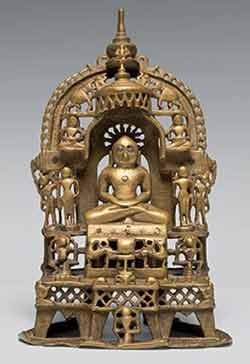
Fig. 11 Image of seated Jina Parshvanatha
with four other Jinas, Gujarat,
14th century. Cat. 126.
If we look at the artistic evidence, the Jina (the
Victorious One) and the Buddha (the Enlightened One), historical founders of the two religions known today as Jainism and Buddhism, are always represented
as renunciates. The Buddha is a monk exhibiting a variety of postures and gestures, a cranial bump of wisdom being his most distinguishing feature. In
early images, these gestures synoptically depict important events in the Buddha’s life, but they later come also to symbolize the cosmic and transcendental
nature of Buddhahood. Mahavira (the last of the twenty- four Jinas of the current cycle and founder of Jainism), too, is represented as a monk, yet with
more limited artistic forms and minimal iconographic diversity.
A Jina, also known as Tirthankara (the Forder), is portrayed nude (Digambara, skyclad), which probably is the earlier mode, as is evident from the
surviving images from Mathura of the first century of the Common Era. An early designation of the Jains in literature is Nirgrantha (without clothes). The
nudity of the monks came to be considered an extreme sign of asceticism along with some other unconventional practices and may have caused societal
problems.[5] Some dissenters began wearing simple white cotton cloth and came to be known as Shvetambara (white clad).
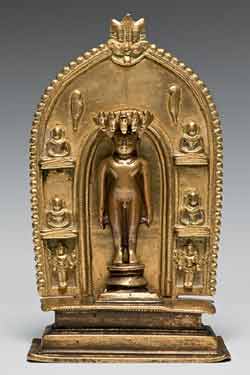
Fig. 12
Image of standing Jina Suparshvanatha
with four other Jinas, Karnataka,
15th century. Cat. 128.
In keeping with their belief in the complete state of non-being as a result of their enlightenment, the Jinas, with two exceptions (Adinatha or
Rishabhanatha and Parshvanatha), are depicted with minimal physical variations, which makes their identification difficult. They are represented either in
the seated posture of meditation (fig. 11, cat. 126) or standing erect like a pillar, arms hanging by the side and not touching the body (fig. 12, cat.
128). Distinctive of Jina images, this posture is known as kayotsarga, generally translated as “body abandonment” or “body sacrifice.” This
minimalism in the iconographic features of the Jina, especially of the Digambara order with their nudity, is in keeping with the extreme spirit of
renunciation advocated by the religion. While in Jainism ultimate liberation could be attained only by one who has renounced the world (samsara)
and adopted the life of a mendicant, practicing extreme austerities, the Buddha in fact eschewed mortification, which allowed for the householder to strive
for final emancipation. He was clearly a doer and declaimed that even if one recited few texts but lived in accord with the Law (dhamma or dharma), one would be liberated.
Deeds, not words (facta non verba), was his mantra. Even though the Buddha himself renounced the life of the householder and went in search of
enlightenment, and did establish a religious order of monks, he recommended a less austere path than did Mahavira. Common to both the householder and the
renunciate was the practice of yogic meditation as a means ( yana) to salvation; a diluted form of this practice captured the imagination of
Western civilization beginning in the
20th century.[6]